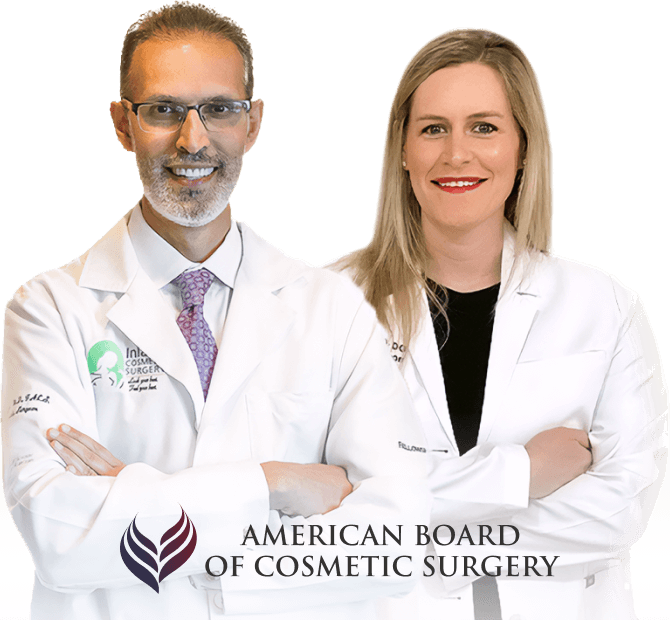Our experienced cosmetic surgeons can help reduce your large, heavy breasts for improved quality of life
Do your large breasts get in the way of you enjoying life comfortably? If a heavy bust is making it difficult to exercise, causing pain, or giving you unwanted attention, a breast reduction may be able to help. Patients who have had breast reduction surgery consider it to be a life-changing procedure and report a high rate of satisfaction—in fact, 97% of breast reduction patients on RealSelf think the procedure is “worth it.”
By reducing the amount of breast tissue you have and reshaping the breast mound, an experienced cosmetic surgeon can help give you a new lease on life by reducing or eliminating back pain, stress on the shoulders, and discomfort while running or working out.
Is breast reduction right for me?
Breast reduction surgery may benefit you if you meet any of the following criteria:
- Pain in the upper back, shoulders, and neck caused by weight of the breasts and bra straps
- Large, heavy breasts that sag with downward-facing nipples
- Chafing or skin irritation underneath the breasts
- Difficulties exercising or discomfort with physical activity due to size of your breasts
- Feeling self-conscious about the size and appearance of your breasts
If you are experiencing any of the above, a cosmetic surgeon certified by the American Board of Cosmetic Surgery can help determine if breast reduction surgery is a good fit for you during a consultation.
“Dr. Haiavy and his entire staff are amazing. They are very caring and take the time to listen and answer all your questions in depth.”
Your breast reduction surgery in Rancho Cucamonga
Our Rancho Cucamonga cosmetic surgeons Dr. Jacob Haiavy and Dr. Emma Ryan have decades of combined experience helping women feel more comfortable with their breasts. Our patients report high satisfaction with the procedure, including relief of chronic back pain, new wardrobe flexibility, and minimal loss of sensation (compared with feedback from past surgical techniques).
Your breast reduction will be performed in our state-of-the-art surgery center located in Rancho Cucamonga. To ensure your comfort, breast reduction surgery is performed under general anesthesia. Depending on the size of your breasts, whether or not sagging skin will need to be addressed, and how much breast tissue you want removed, your surgeon will use one of the following breast reduction incision types:
- “Lollipop” or vertical breast reduction. This is most often used for patients who want a moderate size reduction and have sagging that needs to be addressed. One incision is made around the outer edge of the areola, and a second incision is placed vertically from the bottom edge of the areola to the crease beneath the breast (inframammary fold).
- “Anchor” or inverted T breast reduction. Typically reserved for patients who require a lot of reshaping and need a significant reduction in size, this incision pattern involves three incisions: one around the areola, a second running from the areola to the inframammary fold, and a third along the breast crease in the shape of an anchor.
Through these incisions, your cosmetic surgeon will remove excess breast tissue, fat, and skin, taking care to retain a natural, symmetrical appearance. Often, we move the position of the nipple/areola complex higher up on the breast to give a more youthful appearance. Once the extra tissue has been removed, your surgeon will reshape the remaining breast tissue and skin and then suture and dress incisions.
After you wake up, the initial grogginess of anesthesia wears off, and you get the “all clear” from your surgeon, you will be allowed to go home—though you’ll need a ride and someone to help you around the house for the evening. Your breasts will be bandaged, and it’s normal to feel pretty sore for the first few days. We will prescribe pain medication to help keep you as comfortable as possible during your initial recovery.
Scarless breast reduction
Scarless breast reduction is the procedure that reduces the size of your breasts with no visible scars. This technique of breast reduction surgery involves removal of excess fatty tissue in the breast without removal of skin. This can be performed with the tumescent technique of liposuction or VASER Lipo. With this technique, small incisions (1 cm or less) are made under the fold of the breast as well as in the axillary (armpit) region.
With this technique, we rely on the patient’s own skin elasticity to shrink and elevate the nipple and areola. Older patients, those who already have moderate to severe sagging, and those who require a large reduction may not be eligible for this procedure. Our cosmetic surgeons will assess the condition of your skin and recommend the best breast reduction technique to meet your needs.
- Key Benefits
- Glossary
- Reduced Back and Neck Pain: Large breasts can contribute to pain in the back, neck, and shoulders, and reduction can significantly alleviate this discomfort.
- Increased Physical Activity: With smaller and lighter breasts, physical activities and exercise can become more comfortable and enjoyable.
- Decreased Skin Irritation: Reducing breast size can minimize skin irritation and rashes that often occur beneath the breast crease.
- Reduced Breast Sagging: The surgery can lift and reshape the breasts, reducing sagging and improving their overall appearance.
- Anesthesia: Medication administered during surgery to prevent pain and discomfort, typically general anesthesia in breast reduction.
- Areola: The pigmented area surrounding the nipple, which can be resized or repositioned in breast reduction surgery.
- Breast Ptosis: Medical term for sagging or drooping breasts, often a consideration for breast reduction.
- Gigantomastia: Excessive breast growth, sometimes necessitating breast reduction.
- Incisions: Surgical cuts made during breast reduction; their patterns and locations vary depending on the technique used.
- Inframammary Fold (IMF): The natural crease under the breast, a common site for incisions in breast reduction.
- Liposuction: A procedure to remove fat, occasionally used in breast reduction to remove excess fatty tissue.
- Mammoplasty: General term for breast surgery, including reduction.
- Pedicle: Tissue left intact in breast reduction to preserve nipple and areola blood supply and sensation.
- Recovery Period: The time required after surgery for healing and return to normal activities; specifics vary for each patient undergoing breast reduction.
- Reduction Mammoplasty: Medical term specifically for breast reduction surgery.
- Tissue Necrosis: Potential complication involving the loss of blood supply to tissue, a risk in breast reduction.
- Vertical Scar Technique: A breast reduction method resulting in a “lollipop” scar around the areola and down the breast.
- Wise Pattern Technique: A technique creating an anchor-shaped scar in breast reduction.
How long does it take to recover after breast reduction?
Immediately after surgery, you’re not going to feel great. Take the first day or two to take it easy and allow a friend or loved one to baby you a bit. While getting up some to walk and keep circulation going is important, you won’t feel like being up and around for long. Your chest and shoulders will feel sore, tight, and difficult to move, so you may need assistance getting dressed. Most of our patients feel comfortable switching prescription medication to an OTC pain reliever within 3-5 days.
Typically, our patients can start driving and return to their non-physical jobs after about a week, once they’ve stopped taking prescription pain medication. This can vary based on your individual ability to heal and how involved your procedure was.
While you’ll start feeling more normal over the first two weeks or so, you’ll still need to avoid strenuous activity—no exercise for at least three to four weeks! Your surgeons will give you a specific timeline for when you can resume normal activities.
Learn more about your options at a private consultation
If you have any questions or would like to find out if breast reduction is right for you, please don’t hesitate to contact us. We would love to sit down with you for a one-on-one consultation to review your options and get started on helping you feel more comfortable and confident.
Areas served:
Medically reviewed by Dr. Jacob Haiavy — Updated on Apr 10, 2025


